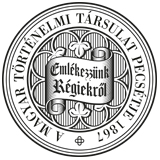Századok – 1999
Tanulmányok - Tóth Endre: Szent Adorján és Zalavár I/3
40 TÓTH ENDRE a Benedictine monastery on the island surrounded by the branches of the Zala around 1024 (AnPosoniensis, SRH I 125, DHA nr. 14, 17). The present article deals with the person of Saint Adrian, the causes of choosing him as a patron saint in the ninth century, the survival of his worship, and the reasons of its reinforcement in the eleventh century. These questions are interesting because it is quite unique that a patrocinium of the ninth century should survive in Transdanubia for the later centuries. Adrian was not held is special veneration there either in the ninth or in the eleventh century that would account for King Stephen's measures. What is more, the presence of the body of a martyr was not common at all in a church of the Carolingian Ostmark, however important this church was. Founding a monastery in a marshy lowland was also quite unusual as all the former monasteries had been built on hills. The saints specially honoured by the king were Michael, Martin, George, and Virgin Mary, and Saint Adrian did not belong to the favourite saints of the Benedictine order, either. The king must have had special reasons for founding the church and the monastery there and then and dedicating it to Saint Adrian. What were these reasons? The conclusions I arrived at are the following: 1. The sentence referring to Adrian in the Conversio does not belong to the original text but is the interpolation of the gloss recorded in the archetype. The words In qua ecclesia Adrianus martyr humatus pausat are different from the terminology used both in the Conversio and in contemporary diplomas. The usual terms sanctus and martyr Christi are missing. In the case of the relics of a martyr the words used almost without exception, for example, in the Ai-nulfianum go as follows: ad Mosaburch abbaciam, ubi sanctus Adrianus martir Christi requiescit. This indicates that at the time of the composition of the Conversio the sacred bones were not at Mosaburg yet or its author made no mention of them. 2. The church built by artisans of Salzburg was not consecrated either by Archbishop Liupramm or by Archbishop Adalwin. The CBC writes only about its construction and the fact that Archbiship Liupramm permitted ecclesiastical activities there but no words like consecravit or dedicavit appear in the texts (see Appendix). So the construction of the church could not have been finished before 875. 3. Irrespective of the actual identity of the corpus, Saint Adrian must have been the martyr of Nicodemia, who came to be celebrated on 8 September in the early Middle Ages following Roman antecendents. The relics could not have been taken to Mosaburg with the assistance of the archbishops of Salzburg prior to 875 as it would have been recorded by the CBC most emphatically as something that was in harmony with the purpose of the document. The relics must have been given to Method by the Pope in return for those of Saint Clement. In that case they must have been taken to Mosaburg before the writing of the CBC, which makes the fact that their existence was omitted understandable. The other alternative is that they got there after 875 but before the Hungarian conquest of 896, which would have involved a significant increase in the significance of the settlement. In that case Arnulfs civitas regia must have been Mosaburg (890: Actum Mosaburc regia civitate, MGH DD Arnulphi Nr. 75; the same is maintained by Bóna István. I return to this later.). 4. The fact that King Stephan I built a church and founded a monastery dedicated to Saint Adrian was due to his kinship with Emperor Heinrich II. In the early days of organizing the Hungarian state and church King Stephen I followed the worship of his brother-in-law. Heinrich II is known to have "girded the sword of Saint Adrian" in 1003 when he launched his campaign against the Slavs, which was unique even in his empire, and prayed to Saint George, Saint Lawrence, and Saint Adrian for victory. King Stephen, who introduced the worship of Saint George, especially honoured in Bavaria, and Saint Michael, worshiped by the emperor (see Bamberg and the Aparatio), most probably wished to emphasize his esteem towards his brother-in-law firt by having a church built at Zalavár and dedicating it to Saint Adrian, then by founding the monastery there in 1024 to remember his death. 5. The survival of the worship of Adrian at Mosaburg until the eleventh centuiy proves that the Christian population of the region preserved its religious culture also after the Hungarian conquest.
